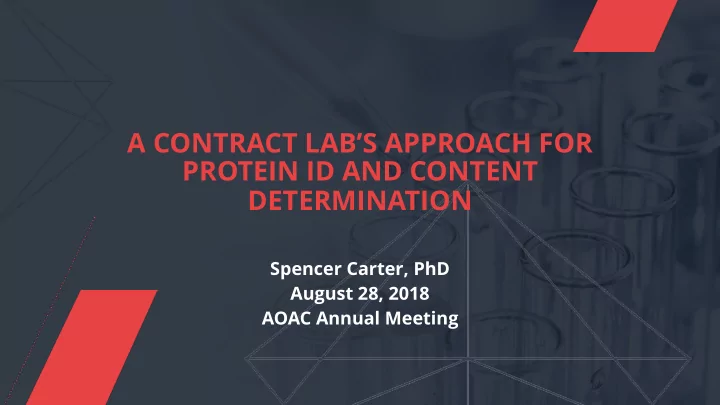

A CONTRACT LAB’S APPROACH FOR PROTEIN ID AND CONTENT DETERMINATION Spencer Carter, PhD August 28, 2018 AOAC Annual Meeting
SIGNIFICANCE OF PROTEINS • Estimated that 4 billion metric tons of food protein is produced globally • Estimated that $94M was lost by changing the nitrogen-to-protein factor for dairy products from 6.38 to 6.25 in Europe in 2006 • Proteins make up $4.7B dollars in the Sports Nutrition industry, which represents 70% of the total revenue in that category DYAD LABS | dyadlabs.com 2
PROTEIN ADULTERATION • Non-selective protein methods have fueled the potential to adulterate samples with non-proteins and give inaccurate results • Melamine, urea, free amino acids cannot be differentiated using Kjeldahl, Dumas methods and have been adulterants • Public health is still at risk; Economics still push adulteration DYAD LABS | dyadlabs.com 3
PROTEIN IDENTIFICATION • Historically, no direct analysis of proteins for identification • Instead, an indirect approach is taken. For example, FCC monograph for whey protein identification requires: • Ash • Fat • Lactose • Loss on drying • Nitrogen (and apply conversion factor) DYAD LABS | dyadlabs.com 4
NEW APPROACH FOR PROTEIN IDENTIFICATION • Dyad Labs (previously Genysis Labs) developed a LC/MS/MS method for identification of proteins in raw materials and finished goods • Method is part of Dyad Labs ISO 17025 accreditation scope • Method received First Action status for AOAC Official Method of Analysis in December 2017 AOAC 2017.11 Pea, Rice and Soy Proteins • AOAC 2017.12 Milk Protein • DYAD LABS | dyadlabs.com 5
AOAC 2017.11 AND 2017.12 METHOD SUMMARY • Enzymatic digestion using trypsin • Separate peptides using Phenomenex Luna C18, 150x2 mm, 3 µm • Shimadzu Nexera for 7.5 minute gradient with A: 0.1% formic acid in water and B) acetonitrile • Sciex API 5500 (triple quadrupole) to monitor three peptides from each protein source • Three peptide peak transitions each have peak area > ~2000 ppm = positive confirmation of protein DYAD LABS | dyadlabs.com 6
PEPTIDE SELECTION • Specific regions of the protein’s amino acid sequence were selected for analysis • Region is unique to the protein being identified • Tryptic peptides from the sequence are monitored DYAD LABS | dyadlabs.com 7 7
PEPTIDE SELECTION EXAMPLE: PEA VS. SOY Pea Vicilin : PFNLRSRGPIYSNEFGKFFEITPEKNPQLQDLDIFVNSVEIKEGSLLLPHYNSRAIVIVTVNEGKGDFELVGQRNENQQ Soy ß-conglycinin : PFNLRSRNPIYSNNFGKFFEITPEKNPQPRDLDIFLSSVDINEGALLLPHFNSKAIVILVINEGDANIELVGIKE—QQQ FFEITPEK EGSLLLPHYNSR GDFELVGQR GPIYSNEFGK FFEITPEK DLDIFLSSVDINEGALLLPHFNSK AIVILVINEGDANIELVGIK NPIYSNNFGK Different cleavage sites Same cleavage sites Same cleavage sites Unique peptides Same sequences Different sequences Identical peptides Unique peptides DYAD LABS | dyadlabs.com 8
EXAMPLE: PEA RAW MATERIAL SAMPLE Rice Pea Milk DYAD LABS | dyadlabs.com 9
EXAMPLE: MILK FINISHED PRODUCT SAMPLE Rice Pea Milk DYAD LABS | dyadlabs.com 10
PROTEIN CONTENT TESTING • Kjeldahl used most for contract lab testing in nutraceutical/food industry • Dumas being used more • Other techniques: amino acids, dye- binding, etc. DYAD LABS | dyadlabs.com 11 11
KJELDAHL METHOD SUMMARY 1. Acid digestion converts nitrogen to ammonium sulfate 2. Neutralize to convert to free ammonia 3. Distill ammonia into boric acid 4. Back titrate with alkali 5. Convert nitrogen concentration to protein using conversion ratio DYAD LABS | dyadlabs.com 12
DUMAS METHOD SUMMARY 1. Combust samples at high temp with oxygen to form water, carbon dioxide, nitrogen 2. Remove water and carbon dioxide using column 3. Nitrogen is measured using a thermal conductivity detector 4. Convert nitrogen concentration to protein using conversion ratio DYAD LABS | dyadlabs.com 13
KJELDAHL/DUMAS SELECTIVITY Dumas determines total nitrogen including inorganic fractions like • nitrite and nitrate Kjeldahl determines only organic nitrogen and ammonia • Neither method is selective, since protein is not directly analyzed • Neither method can detect adulteration; separate analyses by other • methods must be used to do so DYAD LABS | dyadlabs.com 14
KJELDAHL/DUMAS ACCURACY AND PRECISION Dumas typically provides slightly higher recovery than Kjeldahl • Dyad Labs analyzed 25 different samples; Mean recoveries: • KJELDAHL DUMAS 80.9% 81.3% Lysine, nicotinic acid, and other compounds have difficulty digesting and are not • fully recovered using Kjeldahl AOAC 2001.11 reports recovery of lysine at only 87% • Kjeldahl and Dumas provide similar, tight precision • DYAD LABS | dyadlabs.com 15
KJELDAHL/DUMAS ANALYSIS TIME MASTER TITLE STYLE For a batch of ~15 samples, average time for Dyad technician: KJELDAHL (HRS) DUMAS (HRS) Sample Collection 0.5 0.5 Sample Prep 1.5 0.5 Instrument Time 2.5 1.5* Total Time 4.5 2.5 Total Labor 4.5 1 *Dyad instrument can run unattended DYAD LABS | dyadlabs.com 16 16
KJELDAHL/DUMAS SAFETY Chemicals/standards/reagents • used in Kjeldahl: o Concentrated Sulfuric Acid o Sodium Hydroxide o Bromothymol Blue o 95% Alcohol o Hydrochloric Acid o Boric Acid o Catalyst: copper sulfate + potassium sulfate Gases used in Dumas: • o helium o oxygen DYAD LABS | dyadlabs.com 17 17
KJELDAHL/DUMAS COST Estimated* cost per sample for a batch of ~ 15 samples: • KJELDAHL DUMAS $7.50 $4.00 *based on typical batch size; includes direct costs only, such as labor, consumables, and instrument maintenance Dyad charges same price for Kjeldahl or Dumas test • DYAD LABS | dyadlabs.com 18
COMPARISON MASTER TITLE STYLE KJELDAHL DUMAS Analysis Time Ease of Operation Cost Safety Accuracy Precision X X Selectivity DYAD LABS | dyadlabs.com 19 19
CONCLUSIONS • LC/MS/MS provides more selective identification of proteins than other methods • Dumas is the preferred approach for quantitative testing • For total protein testing, the approach Dyad takes is LC/MS/MS for identification, Dumas for quantitative testing, and targeted tests for positive confirmation of potential adulterants DYAD LABS | dyadlabs.com 20
Thank You.
Recommend
More recommend